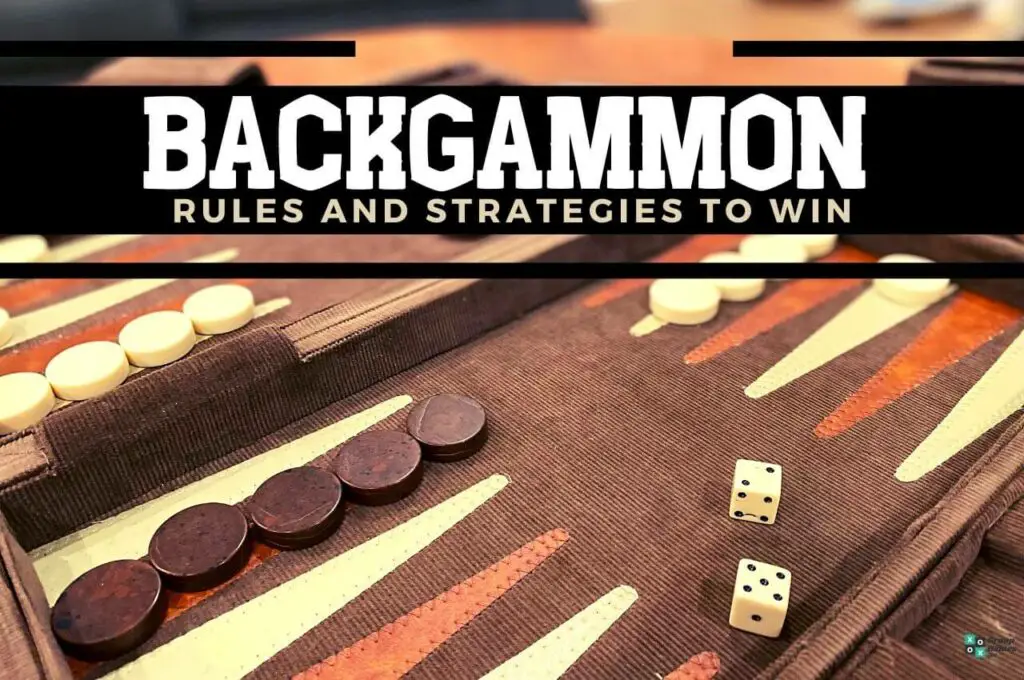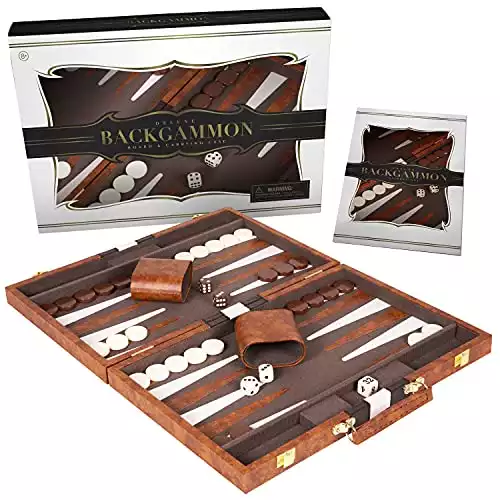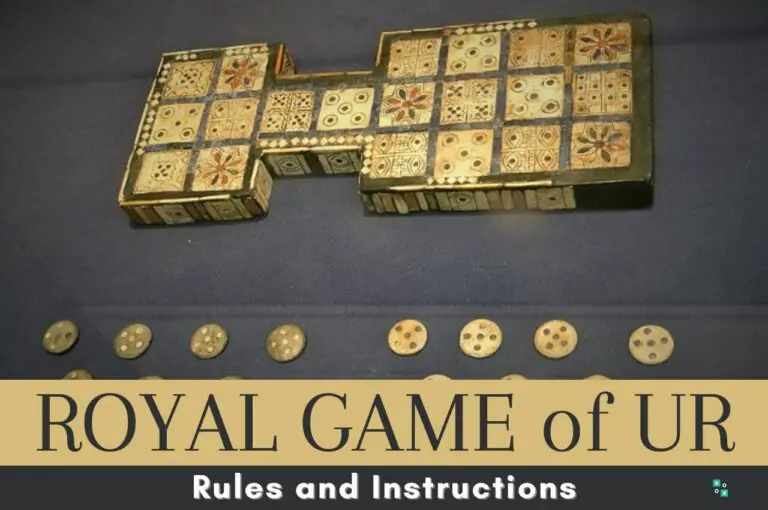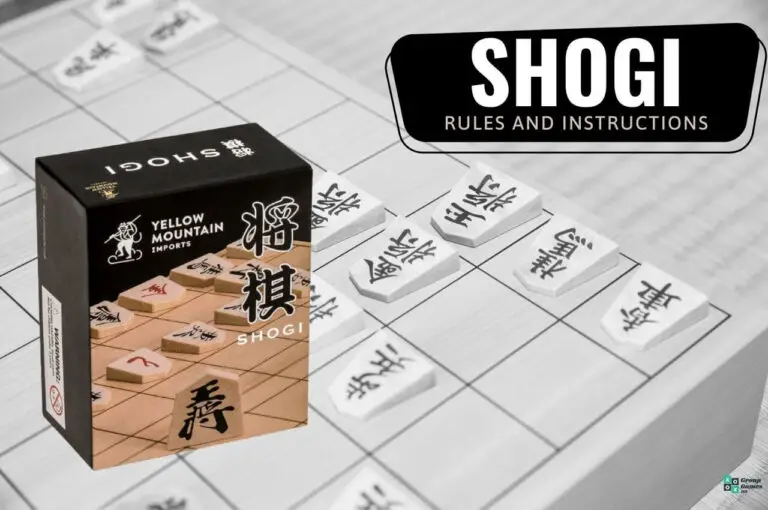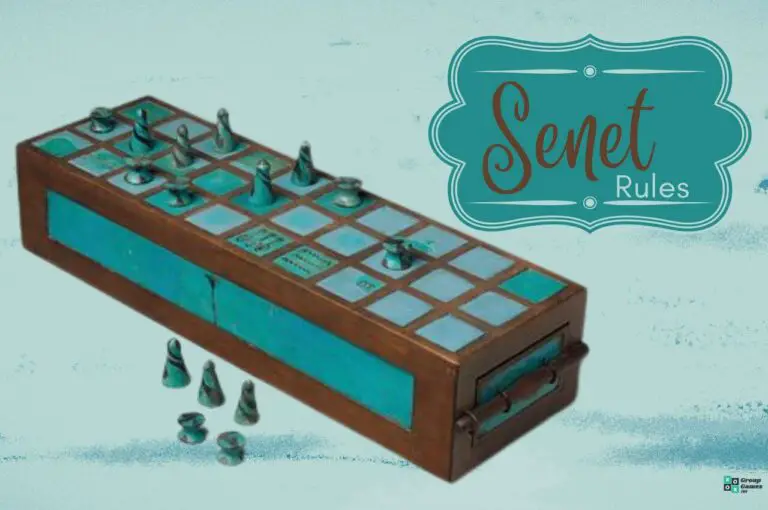Backgammon is a two-player game that has evolved from an ancient Roman game played centuries ago and is still played worldwide today. Want to learn how to play? This article will set out all the Backgammon rules and winning strategies.
In this two-player game, both players race by moving their stones, also called chips, checkers, or counters, around the board based on the roll of two dice. Luck and strategy both play an essential role when it comes to winning Backgammon.
This Backgammon rules guide will cover the following:
- What is Backgammon?
- A brief history of Backgammon
- What you’ll need to play Backgammon
- Backgammon Rules
- How to play Backgammon (Video Tutorial)
- Winning strategies
- FAQs
Read on to learn how to play Backgammon.
What is Backgammon?

Backgammon is one of the oldest known board games. Players roll the dice and move stones strategically around the board to gather all of their stones before their opponent.
Number of Players: 2
Ages: 8+
Difficulty: Medium
Length of Play: 30 minutes
Category: Abstract/Strategy
Similar to: Checkers, Othello, Chess, Mancala
Main Objective: Be the first player to move all 15 stones around the board and retire them from your opponent’s home board space.
Why We Love It: What I love most about Backgammon is the quality and art found among Backgammon game boards. Many are wooden and have beautiful finishes. Quality Backgammon board games are portably enclosed in their leather or faux leather cases.
A Brief History of Backgammon
Historians believe that Backgammon evolved from a game played by the ancient Romans as early as 3000 BC. It continued to evolve, and the doubling cube was added years later to incorporate more challenge and strategy.
Backgammon is thought to have derived from the Middle English words: baec meaning back, and gamen meaning game. This term was first used in print in the year 1645.
What You’ll Need to Backgammon
Everything you need to play comes included in this boxed set. This Backgammon game set comes in three size options: small, medium, or large, as well as five different color options.
This original faux leather box contains:
- Backgammon board
- Playing chips
- 4 Dice
- 2 Dice shakers
- 1 Doubling cube
- Strategy and Tip Guide
Area of Play
To begin, set up your board horizontally and determine which color chips each player will use, black or white. Each player takes both coordinating dice and a shaker cup.
Before playing, it is essential to note that the board comprises triangle spaces called points, and these points are referred to by imaginary numbers ordered from 1-24.
Each player will move their chips around the board in opposing directions.
The center beam located in the middle of the board is called the bar and will come into play throughout the game.
When facing the game board, each player’s starting positions are located directly across from the other. One player starts at the point to their bottom right, and the other player begins at the corner in their bottom left.
The classic game setup begins with:
- 2 black chips on point 1
- 5 white chips on point 5
- 3 white chips on point 8
- 5 black chips on point 12
- 5 white on 13
- 3 black on point 17
- 5 black on point 19
- 2 white chips on point 24
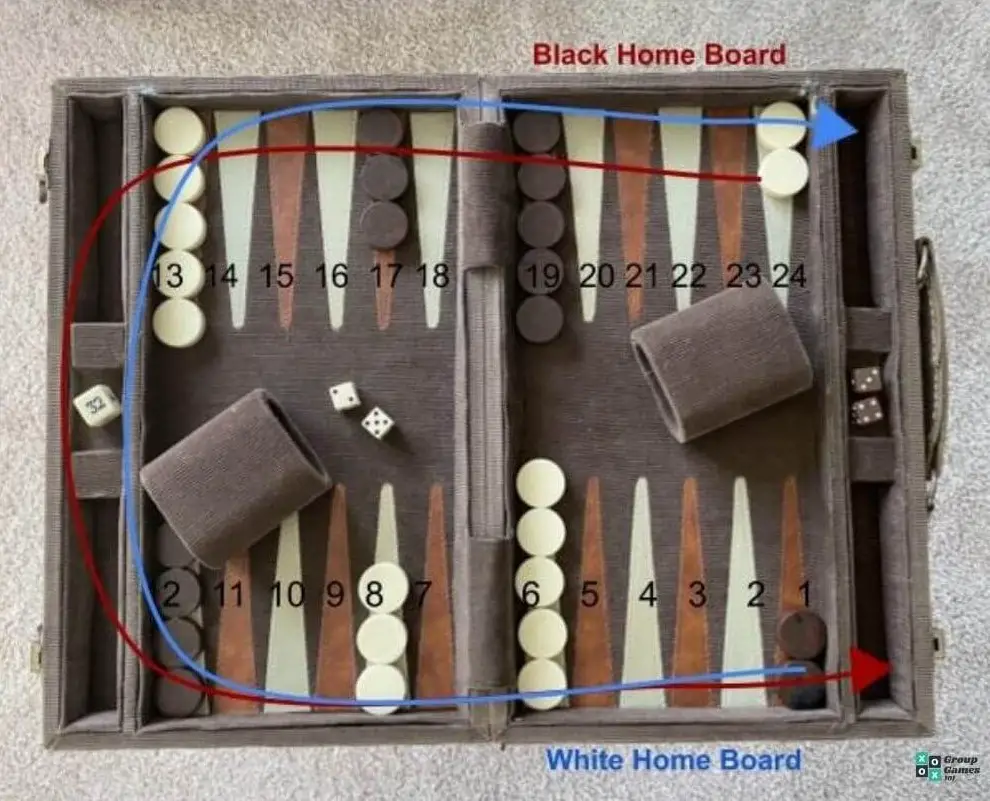
Backgammon Rules
Before starting, both players must agree to a point total goal. The point goal can be any number between 1-25, but it must be an odd number. Many players choose 5, 7, or 9.
Both players begin by rolling one die each. The player with the highest number plays first, but the numbers from both dice must be totaled for the first move.
For example, Player A rolls 3, and player B rolls 5. Player B will move first but must move using the number 8, the total of the two dice: 3 + 5 = 8.
If it is a tie, both players must roll again.
Gameplay
When it is your turn, you must roll both of your dice at the same time into the right-hand section of your board.
Invalid rolls must be redone. For example, if a die lands sideways or outside the board, you must reroll both dice.
Picking up your dice after your roll signals the end of your turn, and you play moves on to the other player. Your play is considered accepted when your opponent rolls their dice following your last action.
The total dice in your roll indicates the number of spaces you can move your chip(s).
You can only move chips onto points under the following circumstances:
- The point is empty and has no chips.
- The point has only one of your opponent’s chips.
- The point already has chips of your color.
A single die number cannot be shared among multiple moves. For instance, if you have a die roll of 6, you must move one chip 6 places, and you can move one chip more than once per turn.
To move your combined dice totals, you must be able to complete the play for that outcome in separate stages. For example, if you roll a five and a two, you must play your chip on the five-point move and then on a two-point move.
If you roll doubles, you will play the number shown on the dice twice, resulting in four moves. You can move any combination of chips when playing these four moves.
Players must use both roll numbers (and all four moves from a double roll) as long as it is legally possible. If you roll a double, but you cannot play all four numbers, you must play as many numbers as possible.
If either dice can be played, but not both, you must play the larger roll. If you can only play one roll, you must play it. If you cannot play either number, you will lose your turn.
Blot
A blot is when a point is occupied by only a single chip of either color. When playing a chip onto a blot of opposing color, the original chip is removed and placed on the bar.
If you have a chip on the bar, your first obligation is to enter those chips into the home board of the opposing player. You must place the chip on any open point corresponding to the numbers shown on the dice. If a point is not available, you will lose your turn.
If you can play some but not all of your chips, you must play as many as you can.
After all, chips have been removed from the bar, unused numbers on the dice must be played next. You can play the chip that was just entered or another chip.
How to Keep Score in Backgammon
Ending the Game
Once all 15 of your chips are on your opponent’s home board, you may begin exiting chips from the game. After rolling the dice, you can remove the chip if it is positioned on a point corresponding to the number on the die.
You don’t have to remove chips from the board if you have other legal moves you would like to play instead.
If there is no chip on the point indicated by the dice roll, you must make another legal move using a chip from a higher-numbered point. If there is no chip on a higher-numbered point, you must retire a chip from the highest point where one of your chips resides.
If you have a chip placed back on the bar during your final play out, you must resolve that chip, bringing it back into play, before exiting any other chips.
The first player to exit all 15 chips wins the game!
Doubling the Stakes
Each Backgammon game begins with one stake per point. Throughout the game, players have the opportunity to double the stakes.
To propose a doubling of the stakes, the player must do this before rolling the dice on their turn.
You can refuse to accept a double by paying on; otherwise, you must take the double and play with the new, higher stakes.
Once you accept the double, you place the doubling cube on your side of the game board, and you will be the only one allowed to propose the next double.
Redoubles occur when stakes are doubled more than once in the same game. If you refuse to accept a redouble, you must pay the number of points at stake before the offer.
If you accept, then the game continues at twice the previous stakes.
There is no limit to the number of redoubles that occur during a game. The redoubling cube helps players keep track of the current stakes.
At the end of the game, if the losing player has retired at least one chip, they will lose only the value shown on the doubling cube.
However, if you have not retired any chips from the game, the losing player will be charged twice the number of points from the doubling cube. This is called a Gammon.
In the worst-case scenario, the losing player is Backgammoned when they still have chips residing in the winner’s home board or on the bar. In this event, the losing player pays three times the value of the doubling cube.
Then, add the points from the doubling cube to the winner, then players can reset and play again. Continue gameplay until the first person achieves the predetermined point total and is declared the winner.
Optional Game Rules
Automatic Doubles: On the first roll of the game, if doubles are rolled, the stakes are automatically doubled, and the doubling cube is placed on the bar displaying the number 2.
Beavers: The player accepting an offer to double the stakes beavers by automatically doubling the doubling cube again. This player will keep the doubling cube until proposing to double again later in the game. The original doubler can accept or refuse this offer.
Jacobe Rule: Gammons and Backgammons will only occur in single games if neither player has offered a double during the game.

Backgammon Winning Strategies
- Double the stakes. Unless you know your opponent has a particular play, it can be beneficial to suggest doubling the stakes to earn more points as the game progresses.
- A sequence of six consecutive blocks is called a prime. You cannot move past a prime that is in place. If an opposing chip is stuck behind a prime, you cannot play it until it is broken.
- When bearing off or exiting chips at the end of the game, keeping an even number of chips on your highest points is essential. Also, try to retire at least one chip as soon as possible to avoid a Gammon.
How to Play Backgammon – Video Tutorial
Frequently Asked Questions
Is Backgammon a Game of Skill or Luck?
Backgammon requires both skill and luck to win. You must play strategically to make the most of every move around the board. Chance comes into play when rolling the dice. Depending upon your chip positions on the board, try keeping an even number of chips on your highest points.
What are the Best Opening Moves in Backgammon?
Many Backgammon experts agree that one of the best opening moves is rolling a 3 and a 1. Moving to a 5 point is also considered the most valuable point in the game. A strong opening move in Backgammon often leads to success towards winning the game.
Can you Move Backward in Backgammon?
Ideally, all chips continue moving forward around the board; however, you can choose to play an optional game rule allowing players to move backward when no legal forwards moves are possible.
Other Games Similar to Backgammon (Our Guides)
If you enjoy playing Backgammon, be sure to check out some of these similar games:

